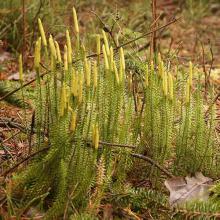Lycopodium clavatum
Common name:
Running clubmoss
Order:
Lycopodiales
Class:
Lycopodiopsida
Phylum:
Lycopodiophyta
Lycopodium annotinum
Common name:
Stiff club moss
Order:
Lycopodiales
Class:
Lycopodiopsida
Phylum:
Lycopodiophyta
Lycopodium clavatum
Common name:
Running clubmoss
Order:
Lycopodiales
Class:
Lycopodiopsida
Phylum:
Lycopodiophyta
Lycopodium annotinum
Common name:
Stiff club moss
Order:
Lycopodiales
Class:
Lycopodiopsida
Phylum:
Lycopodiophyta
Lycopodium clavatum
Common name:
Running clubmoss
Order:
Lycopodiales
Class:
Lycopodiopsida
Phylum:
Lycopodiophyta
Lycopodium annotinum
Common name:
Stiff club moss
Order:
Lycopodiales
Class:
Lycopodiopsida
Phylum:
Lycopodiophyta
Class (Plantae): Lycopodiopsida
Lycopodiopsida is a class of herbaceous vascular plants known as lycopods, lycophytes or other terms including the component lyco-. Members of the class are called clubmosses, firmosses and quillworts. They have dichotomously branching stems bearing simple leaves called microphylls and reproduce by means of spores borne in sporangia on the sides of the stems at the bases of the leaves. Although living species are small, during the Carboniferous, extinct tree-like forms formed huge forests that dominated the landscape and contributed to coal deposits.
The nomenclature and classification of plants with microphylls varies substantially among authors. A consensus classification for extant (living) species was produced in 2016 by the Pteridophyte Phylogeny Group (PPG I), which places them all in the class Lycopodiopsida, which includes the classes Isoetopsida and Selaginellopsida used in other systems. Alternative classification systems have used ranks from division (phylum) to subclass. In the PPG I system, the class is divided into three orders, Lycopodiales, Isoetales and Selaginellales.
Uses
The spores of lycopods are highly flammable and so have been used in fireworks. Lycopodium powder, the dried spores of the common clubmoss, was used in Victorian theater to produce flame-effects. A blown cloud of spores burned rapidly and brightly, but with little heat. (It was considered safe by the standards of the time.)
Reference: Wikipedia


